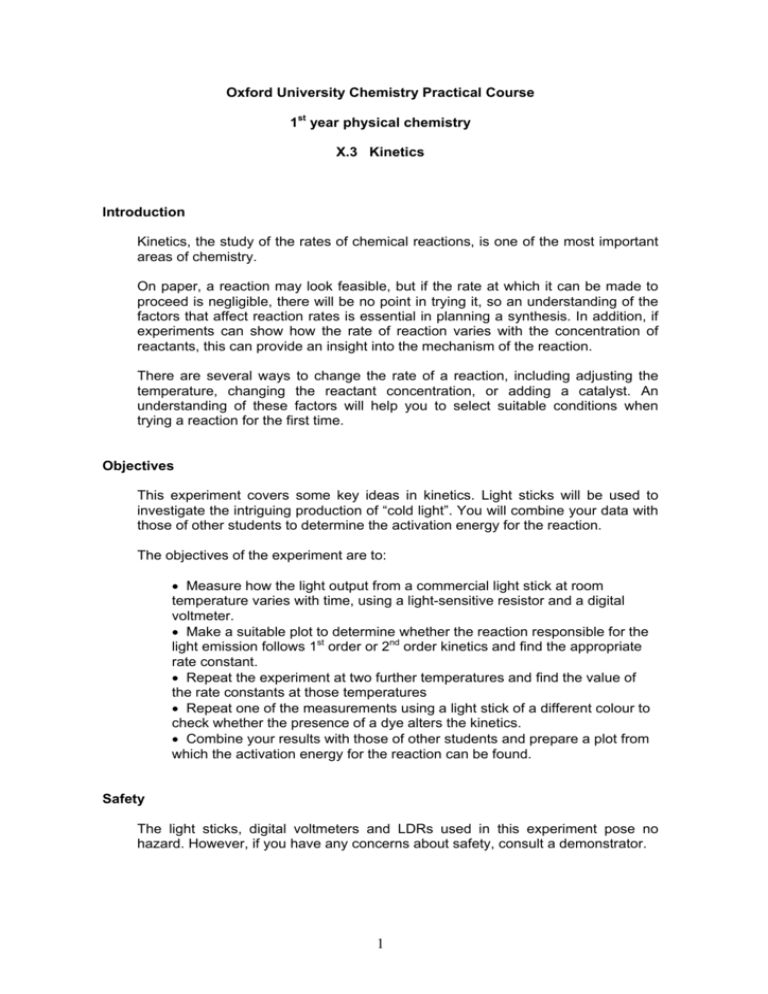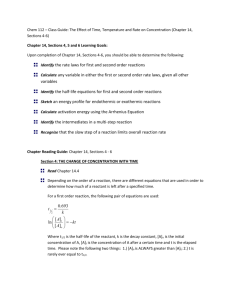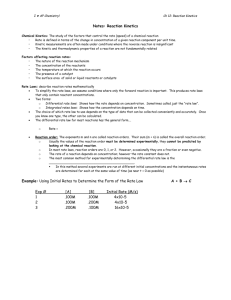Oxford University Chemistry Practical Course 1st year physical
advertisement

Oxford University Chemistry Practical Course 1st year physical chemistry X.3 Kinetics Introduction Kinetics, the study of the rates of chemical reactions, is one of the most important areas of chemistry. On paper, a reaction may look feasible, but if the rate at which it can be made to proceed is negligible, there will be no point in trying it, so an understanding of the factors that affect reaction rates is essential in planning a synthesis. In addition, if experiments can show how the rate of reaction varies with the concentration of reactants, this can provide an insight into the mechanism of the reaction. There are several ways to change the rate of a reaction, including adjusting the temperature, changing the reactant concentration, or adding a catalyst. An understanding of these factors will help you to select suitable conditions when trying a reaction for the first time. Objectives This experiment covers some key ideas in kinetics. Light sticks will be used to investigate the intriguing production of “cold light”. You will combine your data with those of other students to determine the activation energy for the reaction. The objectives of the experiment are to: • Measure how the light output from a commercial light stick at room temperature varies with time, using a light-sensitive resistor and a digital voltmeter. • Make a suitable plot to determine whether the reaction responsible for the light emission follows 1st order or 2nd order kinetics and find the appropriate rate constant. • Repeat the experiment at two further temperatures and find the value of the rate constants at those temperatures • Repeat one of the measurements using a light stick of a different colour to check whether the presence of a dye alters the kinetics. • Combine your results with those of other students and prepare a plot from which the activation energy for the reaction can be found. Safety The light sticks, digital voltmeters and LDRs used in this experiment pose no hazard. However, if you have any concerns about safety, consult a demonstrator. 1 Relevant topics The following topics in the 1st year kinetics course are relevant to this experiment: Rate equation, order of reaction, activation energy and its determination, integrated rate law. Theory The rate of a reaction can be expressed in a rate law, which shows how the rate at which products are formed (or the rate at which reactants are consumed) depends upon the concentration of the reactants. For example, the rate law for the reaction 2NO + 2H2 t N2 + 2H2O has been found experimentally to be: d [ H 2O ] = k[ NO]2 [ H 2 ] dt (1) In this equation the power to which the concentration of a reactant is raised is the order of reaction with respect to that reactant; thus we say that the reaction is “1st order in hydrogen” and “2nd order in nitric oxide”. The overall order of the reaction is the sum of these coefficients, so this is a 3rd order reaction. The orders need not, and often do not, equal the stoichiometric coefficients in the overall equation, so the rate equation cannot be determined directly from the stoichiometric equation. k is the rate constant for the reaction. 20 15 10 5 0 0 20 40 60 80 100 Fig. 1. The variation of reactant concentration with time for a 1st-order reaction. The rates of reactions usually depend upon the concentration of reactants and also on other factors, most notably the temperature. The concentration of most liquids is almost independent of temperature, so, from the rate equation (1), it is apparent that any temperature dependence must be in k. The relationship between k and T is expressed in the well-known Arrhenius equation, in which Ea is the activation energy for the reaction. 2 k = Ae − Ea / RT (2) A is the “pre-exponential factor” or Arrhenius constant. (A does depend somewhat upon the temperature, but much less strongly than the exponential dependence; we shall not be interested in the variation of A with T in the current experiment), R is the gas constant and T is the absolute temperature. The activation energy is often described as a sort of energy “hill” that the reactants have to overcome in order to be able to turn into products. In this experiment you will determine both k and Ea. Equipment You are provided with: light detector, dark box, digital voltmeter, a water bath, black cloth, stopwatch four light sticks of different colours. The light detector is a photoconductive cell, whose resistance depends on the amount of light reaching the diode Planning You have a short time to plan. Several pairs of students will do the experiment at the same time; you do not all need to take the same approach, but you may wish to swap ideas. You can ask the technician for a couple of spare light sticks which you can use to experiment with. First you must record the light output from a light stick at room temperature as a function of time, then repeat the experiment at two further temperatures in the range 0oC to 40oC. At the end of the experiment you will combine your results with those of others in the group to find out how the light output varies as a function of temperature, and hence determine the activation energy. Some questions you might think about before starting work are: Does it matter which part of the light stick you measure light output from? Should you calibrate the detector before use? And if so, how would you do this? Is it important to exclude room light? How long should you take measurements for? How might the light output vary as a function of time? What temperature should you use? Assuming that the reaction depends upon the concentration of only one reactant and is either 1st order or 2nd order, how will you plot your results to determine which is closer to the correct value? (Hint: the amount of light emitted gives a direct measure of the current rate of reaction. If you integrate a rate equation you can find an expression that relates reactant concentration to time.) Devise a suitable procedure to measure the light output as a function of time (if you get stuck, ask a demonstrator for help). The light emission is detected by 3 measuring the resistance of the detector which you can assume is related linearly to the light falling on the detector. Procedure To activate the light stick, bend it. Position the detector near the light stick and take readings of the resistance using the DVM (digital voltmeter). Once you activate the light stick you cannot unactivate it! Repeat the experiment using a different temperature. To do this you will need to partly submerge the dark box in water. Although the detector housing is waterproof, you should be careful not to get the electrical connections wet. Analysis There are various ways in which you could analyse your data from the experiment. Before starting the analysis, discuss with your partner and, if you wish, other members of the group, how to proceed. It is not necessary for all pairs to take the same approach, but however you proceed, remember that you are seeking to find (a) the overall order of the reaction and (b) a value for the rate constant. The simplest way to proceed is to assume that the reaction is first order and to find, or derive, a relationship between the concentration and time that, when plotted, would yield a straight line. If your data do not give an acceptable straight line you can then assume the reaction is second order and repeat the calculation. Record your data and calculations in the tables and boxes below. Temperature of your 1st experiment (room temperature) Temperature of your 2nd experiment (thermostatted) Temperature of your 3rd experiment (thermostatted) Colour of 1st light stick Colour of 2nd light stick: 4 Time 1st run resistance 2nd run resistance 3rd run resistance Run with different coloured light stick Method(s) chosen to find k Value of k at 1st temperature (show your working overleaf and include what you believe to be sensible units) Value of k at second temperature Value of k at third temperature Type of plot to find Ea Value of Ea 5 Appendix 1. The Chemistry of Glowsticks A glowstick consists of an inner, thin walled glass vial and an outer plastic tube. The plastic tube contains a mixture of the dye and a derivative of phenyl oxalate ester (often bis(2,4,6-trichlorophenyl)oxalate (TCPO) because it gives a good quantum yield, in other words, generates plenty of light). Inside the glass vial is concentrated hydrogen peroxide. Activating the glowstick by bending it breaks the glass vial and therefore mixes the peroxide with the phenyl oxalate ester, causing the following reaction to take place: Cl Cl Cl H O HO O Cl H 2O2 O Cl O O O Cl Cl O O Cl O Cl Cl Cl Cl O Cl O + O O Cl 2 HO Cl The peroxyacid ester then spontaneously decomposes to carbon dioxide and the energy emitted excites the dye. Light is emitted when the dye returns to its ground state by emitting a photon, the wavelength of which is determined by the structure of the dye. O O Fluorophore* + 2CO2 + Fluorophore O O Fluorophore* Fluorophore + Light 6







